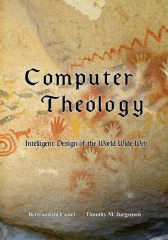PRESS
COMPUTER THEOLOGY |
||||
|
each grew up from infancy, long before we more fully comprehended
the law of gravity, we understood through our observations of repetitive action
that things fall when we drop them. If they’re heavy and they fall on our foot,
then it is going to hurt. Hence,
our experience teaches us that a brick falling toward our foot is worthy of a
fast, corrective response. On the other hand, finding a small pellet of
plutonium in the back of a cupboard might well not evoke an appropriate
response. On finding such a pellet, we will probably be dead shortly, either
from chemical or radiation poisoning, since our typical lack of experience with
the toxicity of plutonium or with lethal levels of radiation might well create
an incorrect assessment of trust. Experience, then, can be viewed as a means
for calibrating our trust assessment facilities, if we live through the
experience. As we noted in an earlier chapter, “That which doesn’t kill us
makes us stronger.” Although ultimately
grounded in experience, trust can also be viewed to derive from habitual
activity. We can be trained to respond “this way” to a given situation. The
connection of sensory input to the stimulus for action is programmed to be
automatic; an effective means for establishing coordinated responses from
members of a group, although sometimes effecting an unfortunate stimulus if the
parameters of the situation have changed without our taking sufficient note.
Soldiers can respond with appropriate actions in the face of debilitating
danger because their training overcomes their fear; that is, the repetitive,
ritualistic action on which their training is based essentially recalibrates
their trust assessment facilities. Repetition of specific sensory input versus
action stimulus in certain situations mitigates what would otherwise be an
overwhelming emotional flood for the uninitiated. One means of
establishing a uniform basis for trust within a group is the use of ritual,
a variant of habitual activity. Various repetitive actions can be used to
instill a common emotional state within a group, and from this emotional state,
a corresponding state of trust can be derived. Hence, an appeal to emotional
anecdotes during the half-time speech by a football coach, followed by a ritual
chant and the admonition to win one for the Gipper, is but one example of the
use of ritual as a means of instilling confidence, an approximate manifestation
of trust within competitive sports teams. An offshoot to
the basing of trust on experience is the redirection of trust through a third
party. I place a great deal of trust in John’s opinions and John exhibits trust
in George, therefore, I have an enhanced level of trust in George also.
Obviously this predicates upon my experiential base through which I establish
trust in John; but it has the useful effect of expanding my horizons of trust
so to speak. This particular mechanism is worth noting, of course, because it
has significant impact within social ecosystems, and it will prove very significant
when we consider the establishment of trust as a comprehensive determinant of
security within computer systems and computer networks. We’ve suggested that trust forms the gating parameter for action
stimuli. This would, in turn, suggest that there is a gradient to trust,
ranging from low to high. We can think of it quantitatively by viewing trust as
a measure of the risk inherent in any aspect of a transaction; high risk of
something being incorrect or going wrong corresponds to low trust; low risk of
something being incorrect or going wrong elicits high levels of trust. In small groups such as a family, a clan or perhaps a small community, trust is established among the various participants over time and is a primary derivative of the group association. Trust begets confidence in policy and confidence in policy begets altruistic action that may benefit the group at the expense of the individual. Indeed, it is our view that trust is the overarching trait of the evolutionary success of groups. Within a group environment, a person acquires a reputation as a trusted individual through actions or patterns of behavior applied consistently during a |
||||
|
||||
© Midori Press, LLC, 2008. All rights reserved for all countries. (Inquiries) The contents of ComputerTheology: Intelligent Design of the World Wide Web are presented for the sole purpose of on-line reading to allow the reader to determine whether to purchase the book. Reproduction and other derivative works are expressly forbidden without the written consent of Midori Press. Legal deposit with the US Library of Congress 1-33735636, 2007.
|
ComputerTheology Intelligent Design of the World Wide Web Bertrand du Castel and Timothy M. Jurgensen Midori Press, Austin Texas 1st Edition 2008 (468 pp) ISBN 0-9801821-1-5 |
Book available at Midori Press (regular) |
